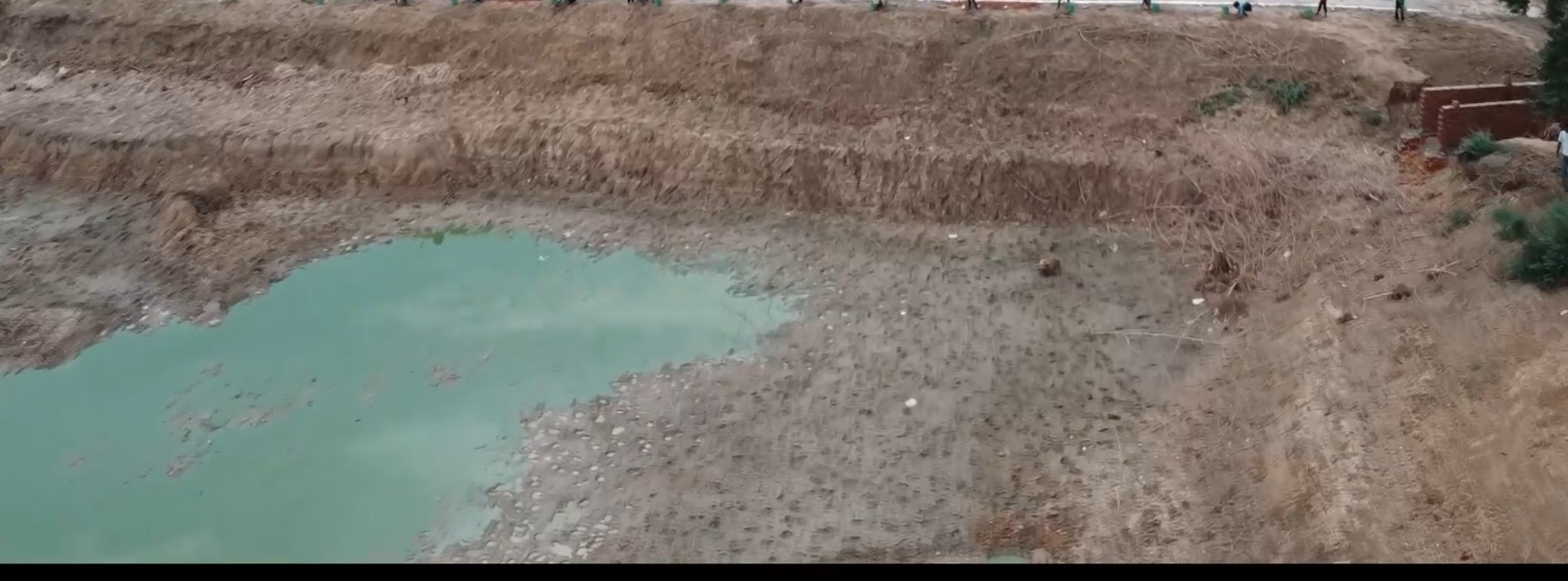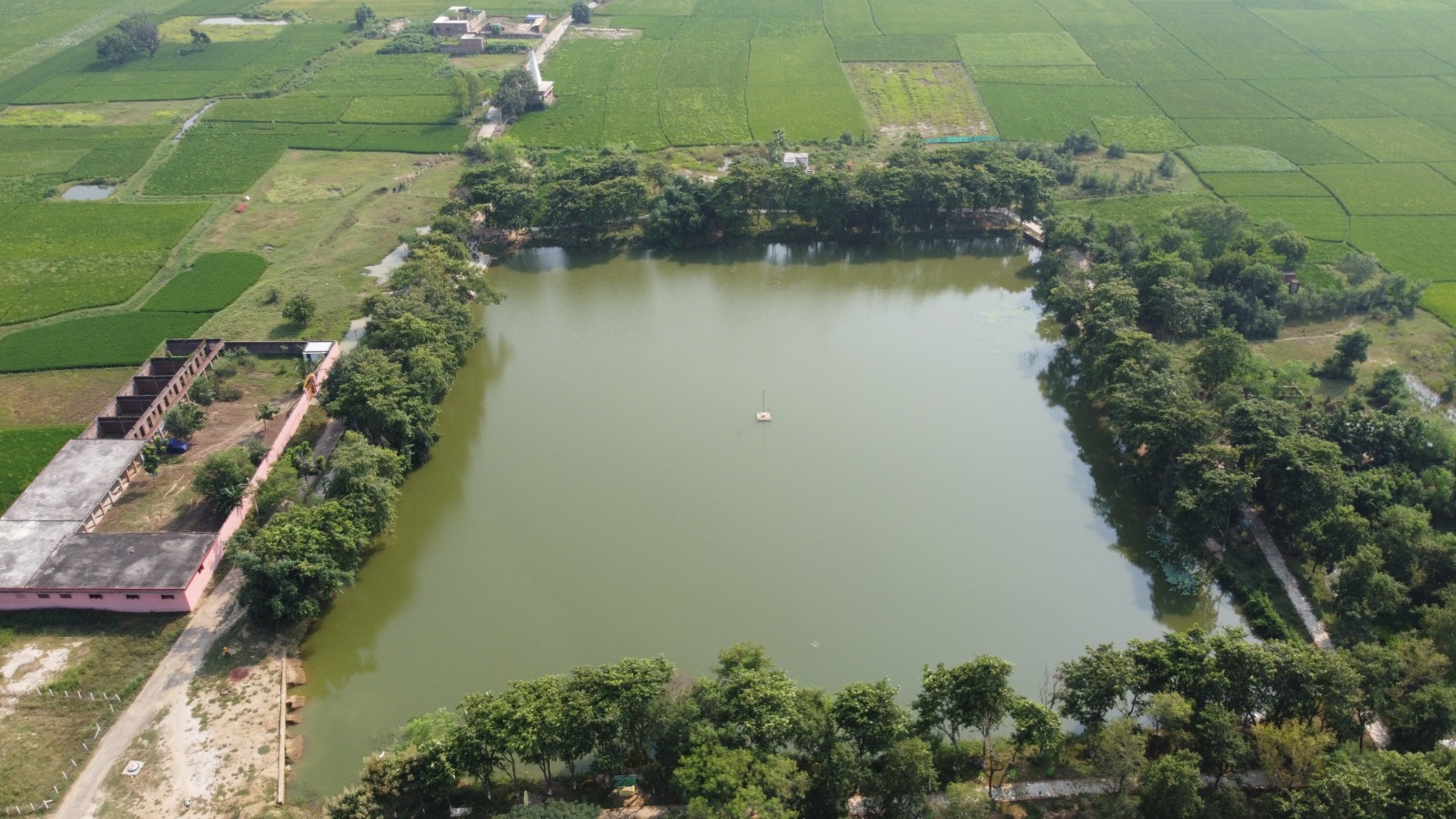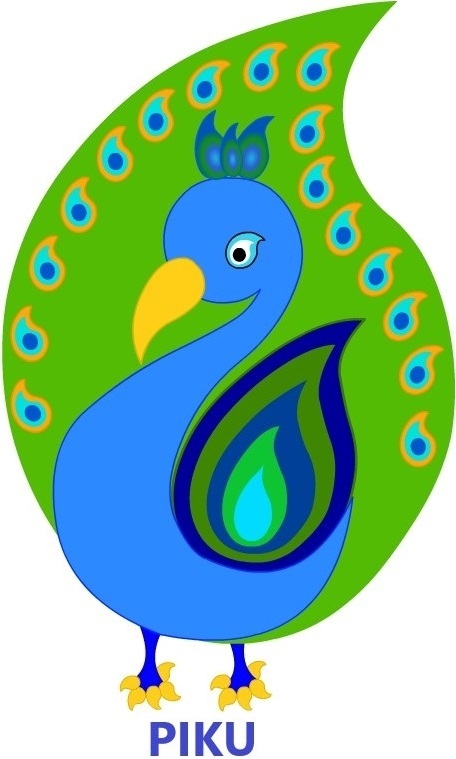Based on the above-mentioned objectives, inventions were targeted for efficient coordination between schemes and departments and their effective execution. With the cooperation of public representatives and members of Panchayati Raj Institutions, 75 Amrit Sarovars in the district were identified for renovation. Two active Panchayat Level Officers and Panchayat representatives were identified and appointed to monitor the work under development of each Amritsar Sarovar. Here, the focus was not only on earthworks and making Amrit Sarovar encroachment free, but also on developing them as a center of celebration and recreational activities for concerned Gram Panchayat. Beautification of Amrit Sarovar banks was ensured, flag hoisting posts were erected, and open gyms and nurseries were developed around them. Hence efforts were made to develop a recreational ecosystem around these traditional pokhars to help local people appreciate its importance as well as integrate these pokhars in their daily lives.
The Minor Water Resource Department has revived several Pokhars of the area of more than……hectare and rejuvenated many Ahar and Pynes. For example, Chanda Pokkhar in Henva village of Chakki Block is rejuvenated by constructing a step protection wall of 114 meters and providing five numbers of outlets. In the process of rejuvenating Dalsagar Pokhar in Buxar Block, a total of 64849 cubic meters of earthwork has been done along with the construction of two inlets. Similarly, Mogasi Pokhar in Dumraon, Hethua Ahar and Pynes in Rajpur, Chillhar and Basav Narayanpur Ahar and Pynes in Itarhi, and Pipararh Ahar and Pynes in Brahmpur were rejuvenated.
Many plantation drives by the MGNREGA Scheme, Jeevika Didis, and Forest departments led to the plantation of saplings around Amrit Sarovar and Ahar-Pynes. This helped in checking encroachments and strengthening their embankments. Under National Innovation on Climate Resilient Agriculture (NICRA), demonstration of water conservation techniques in agriculture, like digging of farm ponds of different dimensions by farmers, have benefitted them as well as rejuvenated many old ponds. Adopting the profession of fishing, Jeevika Didis has also revived many dying ponds. They ensured regular cleaning, reporting, and checking encroachments and also introduced fishlings and water nutrients to keep ponds ecologically vibrant. In Chausa Block, the Nikrish Pump House Project is in progress, which will help in improving the availability of water at the tail end of the Chausa Branch Canal and hence rejuvenate connected Ahar and Pynes.
Buxar is endowed with several traditional water bodies ranging from Ponds to Ahars and Pynes. Along with them, it has a good stretch of the Ganga River as its northern boundary, and Kav River naturally feeds many traditional water bodies. However, these traditional water bodies are generally neglected as they require the integration of efforts of many concerned departments for their rejuvenation and maintenance. Many Ponds, Ahars and Pynes are completely encroached upon by local people. Many ponds are either completely concretized or choked by garbage or sewage. Many Ahars and Pynes are not regularly cleaned and dug, leading to flooding and wastage of surplus water in monsoon. This negligence leads to water logging, poor water table recharge, wastage of rainwater, inequitable access to irrigation water, etc. Hence, now the need of the hour was to understand these humongous challenges and simultaneously convert challenging situations into opportunities of mission-mode multidimensional efforts towards revival of these efforts. Different schemes and concerned departments help in reviving traditional water bodies directly or indirectly. So, in this background, five major departments or schemes were identified which were Amrit Sarovar Scheme, National Mission for Clean Ganga, Jal-Jeevan-Hariyali Mission, Minor Water Resources Department, and MGNREG Scheme. Along with these five pillars, other efforts were also synchronized like initiatives of the Soil Conservation Department, Krishi Vigyan Kendras, etc for the revival of traditional water bodies.
The ultimate objective through the revival of traditional water bodies efforts is to regain the vitality of a network of water bodies that have supported the water needs of Buxar for hundreds of years. The revival of these traditional water bodies will create a strong foundation to fulfill the needs of future generations. These efforts will further help in groundwater recharge, improvement in soil moisture content, availability of surplus water for irrigation, in rain deficit season, equitable distribution of water, etc. Hence, directly and indirectly, resolving other grave issues like poor agricultural productivity and intensity, topsoil erosion, and depletion of groundwater. Here, therefore, the objective was to bring those schemes and departments to a table that would bring significant and multidimensional results in the revival of traditional water bodies at large. The collaboration between the Amrit Sarovar Scheme, National Mission for Clean Ganga, Jal-Jeevan-Hariyali Mission, Minor Water Resources Department, and MGNREG Scheme would amplify positive changes in many folds.
The Amrit Sarovar Mission targeted to development of at least 75 Amrit Sarovars in the district. The pond area of each Amrit Sarovar had to be at least one acre, which will have a water holding capacity of about 10,000 cubic meters. National Mission for Clean Ganga helps in reviving the sanctity and purity of Ganga as well as its unhindered flow (aviral dhara). The ecologically balanced flow and river bed of Ganga support the water table of nearby traditional water bodies. Jal-Jeevan-Hariyali Mission of the Bihar Government has a water component at its core where it integrates fifteen departments to conserve water bodies hence subsequently promoting the significance of the Trinity of Jal-Jeevan-Hariyali in human life. The Minor Water Resource Department aims at rejuvenating big water bodies and Ahar & Pynes. MGNREG Scheme has earthwork like digging and strengthening of soil embankments as its salient feature, hence helping in rejuvenating small river Kav as well ponds, Ahar, and Pynes.
The collaborative efforts of concerned departments have received traditional water bodies at a large scale. A total of 76 Amrit Sarovar developed, and their rejuvenation helped in increasing its water-holding capacity significantly. This also helped in improving the groundwater table of the nearby region and hence helped in the revival of old wells. The water in these ponds is used by farmers at some places for irrigation of cultivated land. Proper maintenance and beautification of Amrit Sarovars have led them to become centers of recreation. People, influenced by the doctors and Yog guru, are enjoying morning walks and yoga sessions around Amrit Sarovar banks. Hence these traditional water bodies have proved themselves as essential natural assets for concerned Gram Panchayats.
Under the Jal-Jeevan-Hariyali Mission, the State government ranks all 38 districts based on their performance on different parameters, and here Buxar stands at first position in the whole state by putting special focus on the development and regeneration of water bodies. A total of 543 ponds (Pokharas), 680 Ahars, and 3382 Pynes are revived. It has created a strong network of revived traditional water bodies across Buxar. Under NICRA, the demonstration of rainwater harvesting structures (farm ponds) has encouraged 55 farmers who have developed farm ponds of different dimensions with a 27.8-hectare total area and 161 lakh liters of water storage capacity.
The Minor Water Resource Department has revived several Pokhars and rejuvenated many Ahars and Pynes. which improved the equitable distribution of water across agricultural fields and the availability of water for irrigation in the sowing period of the Rabi season. National Mission for Clean Ganga’ checked pollution in Ganga and the cleanliness of Ganga Ghats. With the huge and integrated efforts in Nawanagar and Dumraon blocks, under the MGNREGA Scheme, the Kav River is revived. The earthworks in the MGNREGA Scheme have rejuvenated several small ponds, Ahars, and Pynes and also strengthened its boundaries.
The innovative intent in the revival of traditional water bodies demanded preserving the sanctity of these water bodies through minimal disturbance in their ecology and bringing back them at the center of people’s daily lives. Through the engineering assistance of the Minor Water Resource Department and NICRA traditional Pokhara and Ahars-Pynes were rejuvenated. Active participation of people and their representatives was ensured to make these water bodies lively places. Relevant efforts of other departments were converged to revive these water bodies.












